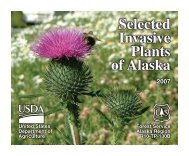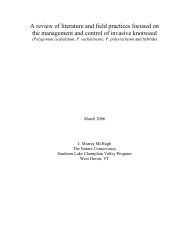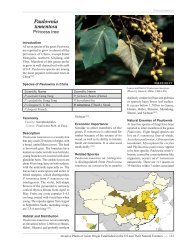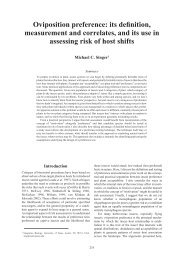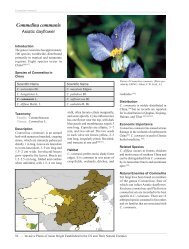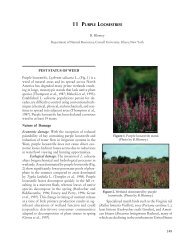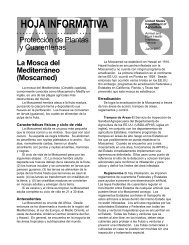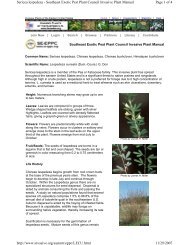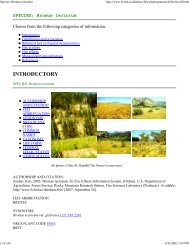5 WATERLETTUCE PEST STATUS OF WEED ... - Invasive Plants
5 WATERLETTUCE PEST STATUS OF WEED ... - Invasive Plants
5 WATERLETTUCE PEST STATUS OF WEED ... - Invasive Plants
Create successful ePaper yourself
Turn your PDF publications into a flip-book with our unique Google optimized e-Paper software.
Biological Control of <strong>Invasive</strong> <strong>Plants</strong> in the Eastern United States<br />
waterlettuce (Mangoendihardjo and Nasroh, 1976;<br />
Suasa-Ard, 1976; Habeck and Thompson, 1994).<br />
Feeding and oviposition also were largely confined<br />
to this plant. The acridid grasshopper Paulinia<br />
acuminata (De Geer) feeds and develops on the<br />
waterferns (Salvinia spp. and Azolla sp.) as well as<br />
waterlettuce (Bennett, 1966; Vieira, 1989).<br />
Releases Made<br />
Only two insects have been released into the United<br />
States as biological control agents against this weed,<br />
the South American weevil N. affinis and the Asian<br />
moth S. pectinicornis (Dray et al., 1990, 2001).<br />
Figure 4a.<br />
BIOLOGY AND ECOLOGY<br />
<strong>OF</strong> KEY NATURAL ENEMIES<br />
Neohydronomus affinis Hustache (Coleoptera:<br />
Curculionidae)<br />
Adult N. affinis (Fig. 4a) weevils are small (3 mm long)<br />
and have a nearly straight rostrum that is strongly<br />
constricted ventrally at the base. Neohydronomus<br />
affinis ranges in color from uniform bluish gray to<br />
reddish brown with a tan, chevron-like band across<br />
the elytra. Further information on the identification<br />
of this species may be found in DeLoach et al. (1976)<br />
or O’Brien and Wibmer (1989). The following summary<br />
of this weevil’s biology is based on DeLoach et<br />
al. (1976) and Thompson and Habeck (1989).<br />
Eggs are cream colored and subspherical (0.33<br />
x 0.4 mm). Females chew a hole about 0.5 mm diameter<br />
in the leaf (usually on the upper surface near the<br />
leaf edge), deposit a single egg inside this puncture,<br />
and close the hole with a black substance. Eggs hatch<br />
within four days (at temperatures above 24 o C).<br />
Young larvae (Fig. 4b), which are very small (head<br />
diameter of 0.2 mm), burrow under the epidermis and<br />
work their way toward the spongy portions of the<br />
leaf at a rate of about 1.5 to 2.0 cm/day.<br />
Larval mines (Fig. 4c) often are visible in the<br />
outer third of the leaf where tissues are thin, but are<br />
less apparent in the central and basal portions of the<br />
leaf. The first molt occurs when larvae are about three<br />
days old, the second molt occurs 3 to 4 days later.<br />
The three larval stages last 11 to 14 days in total.<br />
Figure 4b.<br />
Figure 4c.<br />
Figure 4. Adult (a) and larvae (left) and pupa<br />
(right) (b) of the waterlettuce weevil<br />
Neohydronomus affinis Hustache. Mining by<br />
larvae produces characteristic tunnels (c).<br />
(Photograph courtesy of USDA, ARS<br />
<strong>Invasive</strong> Plant Research Laboratory.)<br />
70


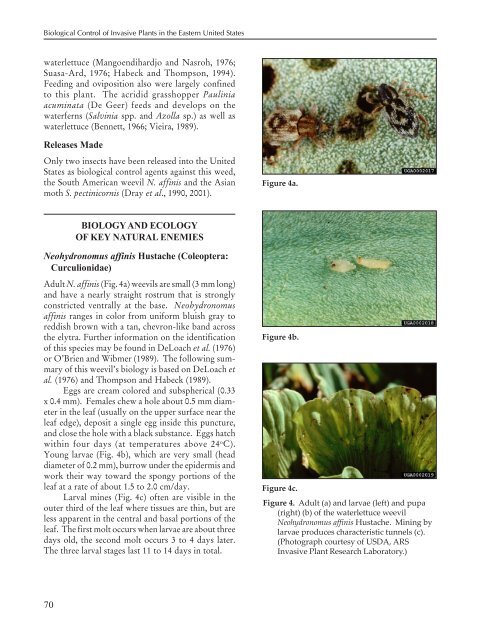


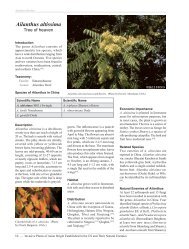
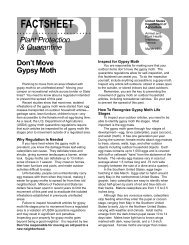
![A Guide to the Control and Management of Invasive Phragmites [PDF]](https://img.yumpu.com/27321025/1/190x190/a-guide-to-the-control-and-management-of-invasive-phragmites-pdf.jpg?quality=85)
